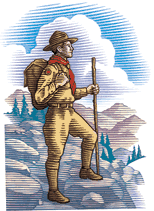![]() September 2001
September 2001

The 400-Mile Trek
By Robert Peterson
Illustration by Bob Dacey
In 1911, a new troop in Minnesota set out on a monthlong, 400-mile hike to attend a special Scout encampment at the state fair.

In the early years of the Boy Scouts of America, many new Scouts plunged enthusiastically into outdoor living. Troops thought nothing of taking a weekly 7- to 10-mile hike for an overnight camp-out, with a horse-drawn wagon or two-wheeled trek cart carrying tents and provisions.
One such unit, Troop 2 in Dover, Ohio, camped out for nearly the whole summer on the banks of a creek four miles from town. Several fathers camped with them, but "when we needed groceries," recalled former troop member Paul P. Turbey, "we sent two kids down the railroad track to Dover, and they carried food back in a wash basket."
St. Paul or bust
In Granite Falls, Minn., the town's first Scout troop planned an even more ambitious outing during the summer of 1911. The dozen 12- and 13-year-olds in the troop undertook an epic hike to St. Paul and back to attend the Minnesota State Fair. Their route covered some 400 miles.
Scoutmaster Tolley Hartwick had organized the troop in 1910, soon after the BSA was officially born. He got the idea for the long hike after hearing that a major Scout encampment would be held at the fair. For months before their July departure date, the Scouts drilled on contests scheduled for the encampment—fire by friction; signaling by semaphore and Morse code; knot-tying; and observation tests.
Years later, former troop member Onni K. Kaslin recalled how the Scouts "started out from Granite Falls city hall on a rainy Monday morning." Tents and some provisions were carried in a horse-drawn wagon driven by one of three older boys who accompanied the Scouts.
Each Scout had a grubstake of $10, safely in the care of Scoutmaster Hartwick.
The troop camped the first night at Wood Lake Indian battlefield, about 10 miles southeast of Granite Falls. After that, Kaslin said, they followed the Minnesota River and Indian trails, averaging about 20 miles on days they didn't stop to visit various landmarks.
Crackers and syrup ... yummm
Mostly the Scouts ate raw fruits and vegetables, canned goods, and such perishables as eggs, which they bought from farmers along the road. "We also received many handouts from people along the way—cakes, cookies, jellies, and other goodies," Onni Kaslin remembered. "In the back of our wagon, we carried a 20-pound box of crackers and a gallon pail of Karo syrup. Lunch was often crackers, dipped in syrup."
At New Ulm, the Scouts saw monuments marking Indian battlefields and were given shelter in a farmer's barn. In the morning, the farmer gave them a parting gift of six bushels of apples.
At Mankato, the Scouts witnessed a practice run of the fire department's horse-drawn apparatus and then enjoyed a swim and a bath at the YMCA. At St. Peter, they toured the state mental hospital, and at Stillwater they visited the Minnesota state prison, where they saw convicts making binder twine.
They even crossed the St. Croix River into Wisconsin (apparently just to be able to say they had been in another state) and then doubled back to the state fairgrounds in St. Paul.
There they set up camp with other troops from Minnesota, Wisconsin, North and South Dakota, and Iowa. Onni Kaslin said 3,500 Scouts attended the encampment, but a newspaper story put the number at 600, which seems more likely. Even 600 would be impressive, considering that the BSA was less than two years old, and Boy Scouts were not common in most communities.
The best at the fair
The Scouts from Granite Lake did themselves proud at the fair. Onni Kaslin and his partner won first place in semaphore signaling, while their troopmates took other honors. Judged "best at the fair," the troop received a new canoe.
Starting home, the Scouts hiked through Minneapolis and camped in the village of Hopkins the first night. A thunderstorm drenched them and spooked the horses, which had to be caught and re-tethered.
"We entered a farmer's granary, took off our wet clothes, and jumped into gunnysacks for a nap," Kaslin recalled. The next day, he said "the farmer was surprised to see who had moved in on him, but took it in stride."
On the last day, they stopped at 6 P.M. in the village of Sacred Heart, only 10 miles from home. Their total grubstake had dwindled to 10 cents, and "our Scoutmaster purchased a dozen doughnuts for supper," Kaslin said.
Then the boys continued on, arriving in Granite Falls about 10 p.m. They had been on the trail for about a month.
"We were welcomed home with a fine reception and banquet at city hall," Kaslin said. "We were glad to be back after being away so long ... It was a great experience and a trip we could never forget."
Contributing editor Robert Peterson is the author of The Boy Scouts: An American Adventure.
September 2001 Table of Contents
Copyright © 2001 by the Boy Scouts of America. All rights thereunder reserved; anything appearing in Scouting magazine or on its Web site may not be reprinted either wholly or in part without written permission. Because of freedom given authors, opinions may not reflect official concurrence.
| The Boy Scouts of America | http://www.scouting.org |